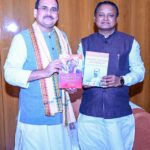THE GLOWING SPIRIT OF OUR CIVILIZATION
- By : Anirban Ganguly
- Category : Articles
It would be interesting to extrapolate some features of a civilisational state into the Indian context and juxtapose them against some present efforts’
The past six months have been positive for India, especially for her quest to rediscover her contours — physical, ideational and spiritual — as a civilisational state. The global acceptane of India’s proposal to observe a ‘World Yoga Day’ by the United Nations has been a glowing expression of this renewed quest to rediscover and project the civilisational dimension in our collective endeavours and in our dealings with the larger world.
In a sense, the Prime Minister’s presenting copies of the Bhagvad Gita to the leaders of the world is also symbolic of that civilisational assertion — a civilisational state never allows its memory to rupture and in its present movements and expressions makes sure to allow the aura, reflection or hue of its best civilisational light to percolate and flow.
The presenting of the Bhagvad Gita and the acceptance and recognition of its primacy in our national life is itself an expression of that flow. Leading Chinese intellectual Zhang Weiwei, in his widely read study, The China Wave: Rise of a Civilisational State, talks of certain essential features of a civilisational state. It would be interesting to extrapolate and weave some of these into the Indian context and juxtapose them against some present efforts.
A ‘super-rich culture’ is a defining characteristic of a civilisational state. A civilisational state not only sees a renaissance, a re-focus on its own cultural threads and achievements but also actively pursues the objective of projecting those cultural-high points through an active reaching out to the world. India has rarely seen such a dynamic outreach in civilisational and cultural terms as it has in the past few months.
For a civilisational state, a ‘super-large population’, another feature, becomes a source of global strength this translated in the Indian context and the Prime Minister’s talk of ‘demographic dividend’ — largest and most dynamic youth population — if tapped and skilled can become India’s greatest asset in the world.
Another feature, the ‘super-vast territory’, gives a ‘certain geopolitical, geo-economic advantages over other countries’ and enables the civilisational state to become the ‘locomotive for regional economic growth and eventually for the world’s economy.
’ One reads the conviction of that higher aim for India, both regional and global, in the Prime Minister’s vision of transforming Saarc into a ‘shared zone of prosperity’ with India spearheading it and in his movement of Make in India, turning India into a major driver of manufacturing.
The recognition of a ‘super-long tradition’ is another vital feature of a civilisational state. In the last six months, in his various interactions across the globe, in the neighbourhood and beyond, Prime Minister has always referred to India’s long tradition and of how it has influenced and shaped the thoughts, customs and practices of civilisations world over.
When the founding document of the Niti Ayog says that institutions of governance must be built, among others, on principles of ‘civilisational history and current socio-cultural context’ it is a recognition that being among the few continuous civilisations of the world India has been capable of ‘evolving, developing and adapting in all branches of human knowledge and practices’ and it was necessary to draw from this civilisational reserve in order to chart out the present course of policy and governance.
In his speech before the Council of Foreign Relations, New York, Prime Minister said something significant. He talked about India trying to work with other countries on the basis of a ‘philosophy’ and said that a “country that works or moves in the shadow of a philosophy sustains for a longer duration” and that India was moving forward with her perennial philosophy of the entire world as a family. A civilisational state evolves and re-formulates a guiding philosophy for its international dealing based on its accrued civilisational knowledge and realisation.
While the messiahs of the proletariat, trapped in their crumbling Xanadu, doth doomsday presage, India’s spirit of a civilisational state is silently re-generating and re-shaping.

















